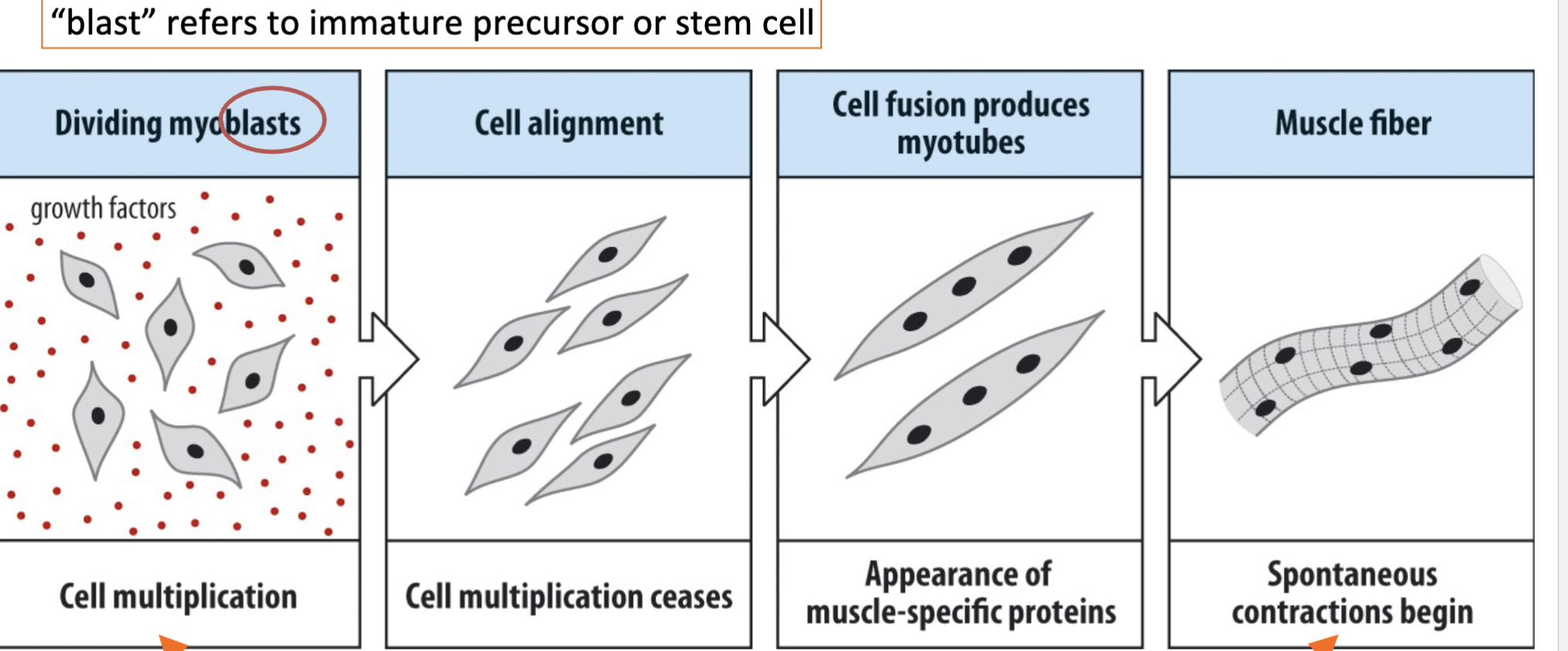Lecture 16 Dev. Bio : Cell Differentiation
1/44
There's no tags or description
Looks like no tags are added yet.
Name | Mastery | Learn | Test | Matching | Spaced |
|---|
No study sessions yet.
45 Terms
Define cell differentiation in simple terms.
It's the process where a general, unspecialized cell becomes a specific type of cell with a unique job in the body.
What are the steps a cell goes through to become fully specialized?
Specification → Determination →Differentiation →Maturation.
What does it mean when a cell is “specified”?
A specified cell is one that will follow a particular developmental path if left in a neutral environment, but it can still change fate if exposed to new signals.
Why does the experiment show no visible differences when the cell is first removed?
Because specified cells have not yet changed appearance or function—they only show differences later as they develop.
What does it mean when a cell is “determined”?
A cell is determined when it is committed to a specific fate and will follow that fate even in a non-neutral environment.
Can a determined cell still divide?
Yes, and the daughter cells it produces will also be determined—they inherit the same fate.
What Is Differentiation? Key Points
🌍 Signals from the outside world tell the cell what to do.
⛔ The cell stops dividing and starts building what it needs for its final job.
🧬 It starts forming the structures and doing the functions specific to its fate.
🧭 Its history (where it came from) limits what it can become—like a fork in the road, it can pick from a few related paths, not any path.
What’s the difference between determination and differentiation?
Determination is when the cell commits to a fate (internally). Differentiation is when the cell starts actually becoming that fate—physically and functionally.
What does a cell's developmental history mean?
A cell’s past affects its future.
What Is Maturation?
🛑 Mature cells stop dividing or divide very rarely (like neurons or red blood cells).
🔒 They are locked in—they can’t switch fates anymore.
🧬 They express the genes, build the proteins, and take on the form and job they were meant for (e.g. a mature muscle cell can contract).
What is the main difference between a differentiated cell and a mature cell?
A differentiated cell is on its way to its specialized form, while a mature cell has fully developed its specific structure and function.
Differentiation isn’t just about how a cell looks—
it’s about what it builds and what job it performs.
Ex: Why does a red blood cell make hemoglobin but a neuron doesn’t?
Because only red blood cells are specialized to carry oxygen, so only they express the gene for hemoglobin.
How do we know a cell is fully differentiated?
It expresses proteins unique to its function—like hemoglobin in red blood cells or insulin in pancreatic cells.
“HOW DO YOU KNOW WHATS GOOD FOR ME”

Why don’t cells keep dividing while differentiating?
Because division and differentiation are mutually exclusive—cells need to stop dividing to focus on changing their identity and function.

Summary of the Process: From Myoblasts to Muscle Fibers
🔴 1. Dividing Myoblasts (Cell Multiplication)
Myoblasts = immature muscle stem cells.
They proliferate in the presence of growth factors.
They’re not specialized yet—just multiplying.
🔄 2. Cell Alignment (Stop Dividing)
Once they get the right signals, they stop dividing and begin to align.
This is the start of differentiation.
Division halts when differentiation starts = mutually exclusive.
🧬 3. Cell Fusion → Myotubes
The aligned myoblasts fuse into long, multinucleated cells called myotubes.
They now start making muscle-specific proteins (like actin, myosin).
💪 4. Mature Muscle Fibers
Myotubes develop into functional muscle fibers.
They contract on their own—showing that they’re fully mature.
1. Specification: Gene expression
Some genes start to change (expression begins to shift).
These changes are temporary—the cell can still switch paths.
🧠 Think: cell is “trying on hats.”
2. Determination : Gene expression
Now gene expression is stable and specific to one fate.
These gene patterns are passed on when the cell divides.
🧠 Think: cell signed a contract—no more changing paths.
3. Differentiation : gene expression
The cell starts expressing genes needed for its specific job.
These are called differentiation genes (like actin for muscle).
🧠 Think: cell starts building its career tools.
4. Maturation : gene expression
The cell is now expressing only the genes it needs, and shuts down others.
These are highly specific genes (e.g., hemoglobin in red blood cells).
🧠 Think: final form—cell is specialized and streamlined.
We’re tracing how a mesodermal progenitor (a stem-like cell) becomes a mature skeletal muscle fiber, step by step, focusing on gene expression changes.
🔹 Stage 1: Determination
Triggered by extracellular signals (e.g. growth factors).
Activates muscle determination genes:
🧬 MyoD, mrf4, myf5These genes push the cell into a muscle-specific path.
Positive feedback loop: e.g. MyoD can keep itself on and even activate muscle development in neighboring cells!
🔸 Stage 2: Differentiation
MyoD, mrf4, and myf5 trigger expression of differentiation genes like myogenin.
These drive the creation of muscle cell structure/function features.
Growth factors are often inhibited to allow this process to occur.
🔴 Stage 3: Maturation
Genes like myogenin turn on muscle-specific genes.
These genes build specialized muscle proteins (e.g. actin, myosin).
The cell becomes a fully functional muscle fiber capable of contraction.
Step-by-Step Breakdown: Positive feedback loop!
Gene on DNA is activated → transcription begins.
The gene is transcribed into mRNA.
mRNA is translated into protein.
That protein loops back to the gene and increases its own transcription.
Why is positive feedback important in cell fate decisions?
It stabilizes gene expression patterns so that once a fate is chosen (e.g. muscle), it’s locked in and self-sustained.
ex: MyoD
What is the role of growth factors in cell fate?
They promote cell division (proliferation) and block differentiation.
What must happen for cells to start differentiating?
Growth factors must be removed or suppressed, and differentiation factors must be introduced.
What role do extracellular signals play in muscle differentiation?
They trigger the activation of muscle determination genes (e.g. mrf4, MyoD).
What does terminal differentiation mean?
It means a cell has reached a stable, final identity with specific structure and function.
What is a master regulatory gene?
A gene that can control the expression of many other genes and determine cell identity (e.g. MyoD for muscle cells).
A gene that can control the expression of many other genes and determine cell identity (e.g. MyoD for muscle cells).
The Experiment: Chick blood cell and human cancer cell
Scientists fused a differentiated cell (e.g. chick red blood cell) with a proliferative cell (e.g. human cancer cell).
Chick red blood cells have a nucleus but no gene activity—they’re "silent."
After fusion, chick genes got reactivated!
The cytoplasm of the human cancer cell contained factors (like transcription factors or activators) that could wake up the silent chick genome.
That means: gene expression isn’t permanently shut off—it's just regulated by cellular context.
The Experiment: human liver cell and mouse cell
Fused a human liver cell (which doesn’t express muscle genes)
with a mouse muscle cell (which does).After fusion, the human muscle genes (which were silent)
became active.
🔍 What Does This Prove?
The muscle cell had factors (transcription factors, regulatory proteins) that could activate genes in the other cell.
Differentiated cells are still flexible—their gene expression can be altered if given the right cues.
How fixed are the functional properties of a cell?
The differentiated state of a cell can be reversed.
De-differentiation
A differentiated cell can lose its specialized features.
Loss of specialized function
Morphology and function revert to a more “immature” state.
Re-entry into the cell cycle
These cells can start dividing again, which is rare for most terminally differentiated cells (e.g., neurons, muscle cells).
Re-differentiation
becoming the same specialized type again
Trans-differentiation
switching directly into a different specialized cell type
De-differentiation
Sometimes, a mature cell can go backward due to injury or signals.
It becomes less specialized again — almost like rewinding development.
Trans-differentiation
This can happen two ways:
Directly – the cell jumps straight from one type to another (e.g., liver → neuron)
Indirectly – the cell first de-differentiates, then re-differentiates into a new type
⚠ Either way, the cell must turn off the old genes and turn on the new ones, which changes its job and behavior!
What usually triggers de-differentiation in mature cells?
issue injury or cell loss (ablation).
What two conditions must be met for a cell to de-differentiate?
The cell must be competent, and the environment must provide the right signals.
Yamanaka factors
Scientists can artificially add 4 key gene regulators:
Oct4
Sox2
Klf4
c-Myc
They make adult cells act like stem cells again.
The resulting reprogrammed cells are called iPS cells (induced pluripotent stem cells).
How can scientists test whether an iPSC is pluripotent?
By injecting it into a mouse and checking if it forms a teratoma containing tissues from all three germ layers.
What does it mean if iPSCs contribute to all tissues, including germ cells, in a chimeric mouse?
It confirms that the iPSCs are pluripotent—they can form any cell type in the body.
What is a chimeric mouse, and why is it important for testing pluripotency?
A chimeric mouse has cells from both the host embryo and the iPSCs. It’s important because if iPSCs can integrate and become all cell types, that proves they’re pluripotent.
How can pluripotency be tested in vitro?
By removing growth factors and adding differentiation signals, iPSCs can be directed to form any cell type, confirming their pluripotency in a controlled lab setting.
Why must cellular plasticity be tightly regulated?
Because plasticity helps in tissue repair, but if uncontrolled, it can disrupt function or lead to diseases like cancer.
What is metaplasia, and how is it related to plasticity?
It’s when one mature cell type is replaced by another at an unusual location, possibly through trans-differentiation.
How is cancer related to developmental plasticity?
Cancer cells misuse plasticity by acting like stem cells—dividing, staying immature, not differentiating, and ignoring signals to stop.
Why is Trans-differentiation Gaining Interest?
It's faster.
Less likely to result in cancer.
Keeps cells in a more controlled, mature state.
Better for in vivo (in-body) therapies where proliferation must be tightly regulated.